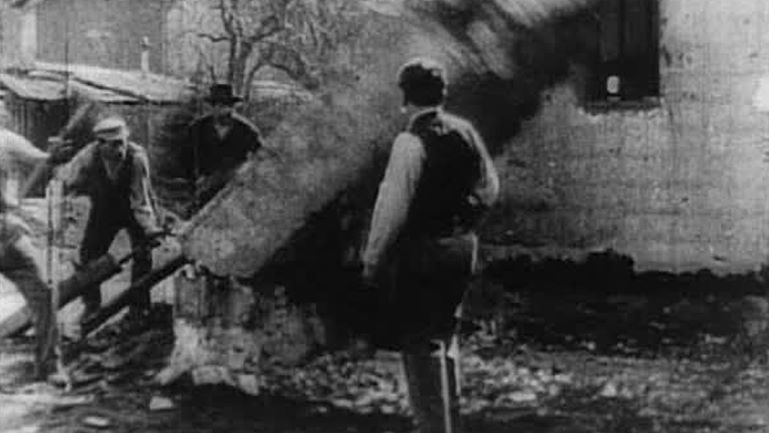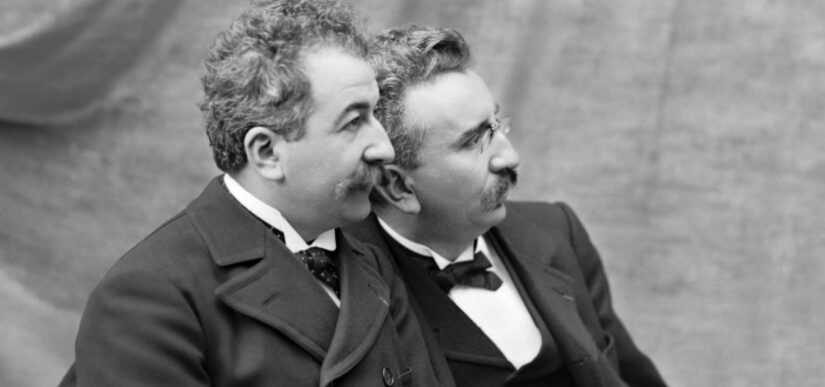The Success of Lumiere Cinema
The success of the cinema was immediate. The watered sprinkler, the only fiction film among those included in the first programs, immediately became the most popular. One wonders whether or not the viewers of the time were aware that the film was a mise-en-scène, but certainly, when the spray of water hit the man’s face, laughter exploded in the room. The sprinkler watered caused an emotional reaction in the audience quite different from that aroused by other films. The one we have chosen as the cover for this page is one of the very first cinema advertising posters.
The Lumières highlight this film which, given its popularity, was soon the subject of numerous remakes by other French directors such asGeorges Méliès or Alice Guy, but not only. What we propose below is the remake made five years later by the Bamforth Comapany in the United Kingdom, The Biter Bit (1900).
Destined to Become Famous
Other Lumière films destined to become famous were The Arrival of the Train at La Ciotat Station (1896) and Demolition of a Wall (1896). During the screening of The Arrival of the Train, some spectators fled the hall fearing that the train would hit them. These episodes are useful to understand how realistic the audience of the time perceived those flickering images, devoid of sounds and colors.
It was not yet the stories or the way of telling them that struck the public but, as we have said, the impression of reality. In this regard it is worth seeing the funny short film by Robert William Paul The Countryman and the Cinematograph (1901) which describes the different reactions of a naive peasant to the images proposed to him by the cinema. In Demolition of a wall, some workers are shown in the act of knocking down a wall. Making the mistake of rewinding the film without turning off the projector lantern, the Lumières discovered the reverse effect: the rubble of the wall jumped up and we went to recompose ourselves in their original structure. They decided to show this film like this: at the end of the screening the film was rewound without turning off the projector lantern. For us who have seen rewinding the tapes of a VHS, this effect has nothing special, but the viewers of the time could cry for a miracle, some even went so far as to have stomach ache.
Arrival of a Train at La Ciotat (The Lumière Brothers, 1896)
Yet the Lumière family were convinced that cinema would be a passing trend, which is why they decided not to sell their devices to anyone, intending to preserve their secrets, and immediately set to work to train new operators who could enrich their films with films catalog before cinema went out of fashion. Louis Lumière took charge of this when he welcomed the apprentices with these words: “ Know that what is offered to you is not a sure future, rather a profession of acrobats. All this can last six months, a year, maybe more or maybe… ”.
The Birth of National Cinema
Nonetheless, Louis Lumière instructed his pupils scrupulously, so much so that their films follow exactly the style of their master. As early as 1896, various Lumière operators began to be sent to the major cities of France and Europe. They soon went as far as the Far East and the Far West. They had the dual task of organizing shows and shooting images of the places they had come to. The arrival of the Lumière operators most often coincided with the birth of national cinema.
Thanks to these trips, the Lumière catalog was enriched with views and panoramas that soon became, together with current events, the most valuable pieces. In an age when there was no television or internet, the public could admire images of cities and faraway places, that he had never seen before and that perhaps he never would have been able to reach. Some of these operators also introduced new shooting techniques; for example to Alexandre Promio, is credited with the invention of the first trolley.

Venice was just one of the many stops on that world tour that Promio made on behalf of the Lumière family between 1896 and 1897. Before arriving in Italy, Promio had been to Spain, England and the United States. Later he reached Egypt, where on the Nile he created other moving views such as the one created on the Grand Canal. Gabriel Veyre, another famous Lumière operator, instead traveled to the East until he reached Japan. In the small village of Namo, in distant Indochina, he took a minute of images holding the camera between his legs as he walked away in a rickshaw, thus creating the first reverse trolley in the history of cinema.
Comparing the films of the Lumière with those of the contemporary Méliès, it is customary to attribute to the latter the invention of fictional cinema and to the former that of documentary cinema. But on closer inspection this is not quite the case. An analysis of The Battle with the Snowballs (1897) can reveal how much fiction there can be in films that appear at first glance to be a real-life scene.
It would appear that the operator ran into a group of playful characters and decided to film them. But if we observe the composition of the shot, the way in which the characters move in the scene that never impale the operator, then we doubt that the scene has been constructed. Consider then, that the operator had less than a minute to film, and it would be somewhat surprising that, in such a short space of time, a reckless cyclist found himself crossing the battlefield at that very moment. Furthermore, this does not come from the end of the avenue, as is clear from the first frames, but starts already in the middle of the path. It is therefore a real staging.



